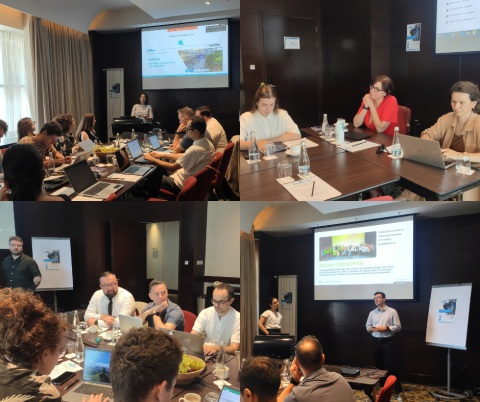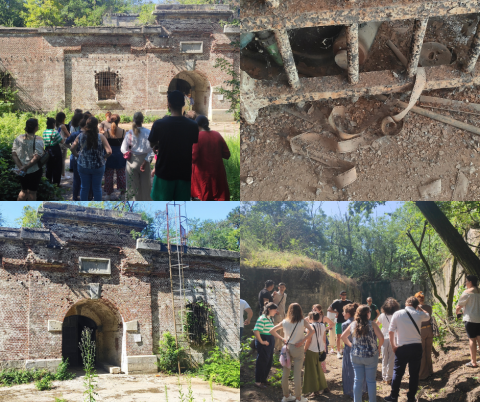IMPETUS second Interregional Policy Brokerage Event

On 11-12 June, the Bucharest Ilfov Regional Development Agency (BI RDA) hosted the second Interregional Policy Brokerage (IPB) event of IMPETUS, bringing together all project partners and regional stakeholders involved in the third-semester activities.
The meeting was a fruitful opportunity to promote exchange and cooperation between partners and improve their capacity to design regional policies, thanks also to the participation of local and international guest experts who shared key insights and learnings from other projects and initiatives.
Thanks to presentations by Ms Laura Martelloni (ANCI Toscana) and Ms Cristina Pavelescu from BI RDA, the experiences of the European projects T-Factor Horizon 2020 and URBACT Greenplace were shared, highlighting key learnings and opportunities for urban regeneration by discussing flexible approaches, participatory tools, and the potential of temporary uses. Further learning was brought by Ms Diana Dobrin and Mr Samuel Stancu drawing on the experience of Urbanize Hub, the leading urban sustainability lab in Central and Eastern Europe. Ms Alexandra Stoica from Proper Architecture presented interesting case studies and legislative issues on revitalising unused spaces in Bucharest and also introduced the Calup platform, an online tool for mapping and reactivating vacant spaces.
The comparison of regulatory frameworks and contractual approaches for temporary uses in different jurisdictions highlighted the importance of effective legislation and contracts to address urban challenges. Ms Federica Castellano (University of Pisa) offered a view of temporary uses of current legislation in Italy, where regional regulations govern TUs without a national framework, leading to varying approaches across municipalities. Mr Valentin Mousain (Lille Metropole) presented an overview of contractual arrangements for transitional management in Roubaix's urban renewal projects that aim to revitalise neglected areas, enhance social cohesion, reduce municipal maintenance costs, and promote sustainability. Ms Blanca Bassas Portús (Departament de Mans al Verd - Ajuntament de Barcelona) concluded with a presentation of the Pla Buits Programme launched by the Barcelona City Council in 2013 to fund temporary activities of public interest in vacant city plots, and the Mans al Verd Programme that aims in engaging citizens in caring for urban greenery and biodiversity.

Partners had also the opportunity to participate in two insightful study visits that showcased innovative temporary uses of historical and industrial spaces, offering practical insights and inspiration for similar initiatives.
The Forts of Bucharest
The XIII-XIV Battery in Jilava is part of the Forts of Bucharest, originally constructed in the late 19th century as a defensive ring. This visit provided insights into the adaptive reuse of historical military structures through supportive regulatory frameworks.
The Forturi.ro project aims to revitalise these forts for residents and visitors, engaging the community in transforming them into community spaces, with the latest initiative envisioning ten accessible forts as models for rehabilitation and urban reintegration, with public feedback gathered at events.
The XIII-XIV Battery has a unique history, having been repurposed in 1956 to store nitrate films, which led to the establishment of the National Film Archive. Forturi.ro's regeneration project envisions the Battery as a national objective managed by the National Film Archive, featuring cinema and new media studios, community centres, cultural activity spaces, libraries, and a museum, with the exterior potentially including recreational areas and an open-air cinema.

Hala Laminor
The second visit was to a former industrial hall that has been transformed into a space for art exhibitions, pop-up markets, and community gatherings. Covering 68,000 square metres, the City Town Hall of Sector 3 aimed to revitalise the area with a project benefiting social, cultural, and economic aspects.
Originally part of the "Malaxa" industrial complex and designed by architect Horia Creangă, Hala Laminor was one of the largest industrial halls in Romania. Taken over by the City Hall of Sector 3 in 2014, restoration and modernisation began in 2017, preserving its original metal structure while incorporating energy-efficient elements and new storage and parking spaces. Plans include converting Hala Laminor into a multifunctional complex with platforms for pedestrian traffic, car access for service and parking, an extended road, a representative urban square, and a network of streets to facilitate access to the site and direct pedestrian flows towards the hall.
